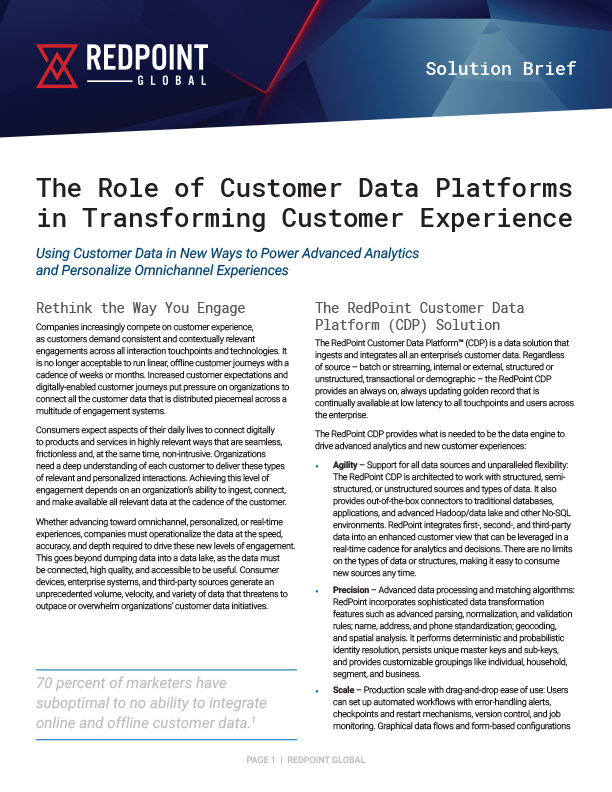 Consumers are generating data at a dizzying pace, leaving bits of information about preferences, habits and activities behind at every touchpoint. Multiple devices and interaction touchpoints including web, mobile, social, email, POS and call centers provide marketers with more information about customers than ever before. Today’s savvy marketers are in turn using this data as the lifeblood to create the personalized experiences their customers expect.
Consumers are generating data at a dizzying pace, leaving bits of information about preferences, habits and activities behind at every touchpoint. Multiple devices and interaction touchpoints including web, mobile, social, email, POS and call centers provide marketers with more information about customers than ever before. Today’s savvy marketers are in turn using this data as the lifeblood to create the personalized experiences their customers expect.
One concern that marketers have is how to manage increasing data volumes while boosting the accuracy and relevancy of their marketing programs. Metadata is the answer. Metadata, in a broad sense, is just “data about data.” But that extra layer of data can imbue meaning to business data, providing the relationships and rules for managing data flow, analysis, and activation in customer engagement systems. To enable this single point of control, metadata is a vital component of any Customer Data Platform (CDP) worthy of the name.
At the data layer, analytics layer, and the intelligent orchestration layer, metadata provides a contextual framework for customer data in terms of how, what, where, when, and why it is being collected and used. Whether for defining, managing, and understanding a marketing program, compiling a golden record, or determining rule-based tasks, metadata powers the routing, rights, and rules to ensure quality and optimize business outcomes.
Building a Foundation for a CDP
Using retail customer experience as an example, a retailer with siloed data, like a POS or e-Commerce system will quickly have problems personalizing the experience at checkout because all they know is what is happening at that very moment.
With a robust CDP that can offer a single point of control over data, decisions, and interactions, the same retailer can create a contextually relevant offer or next-best action recommendation. In this scenario, metadata provides the underlying structure that directs how customer data is used.
At the connected data layer, metadata empowers cleansing, correcting, and validating data about a customer – first, second, and third-party data, structured, unstructured, and semi-structured data – and helps direct the merging and probabilistic matching for online and offline identity resolution. It gives heft to data modeling by providing the tagging, timing, and sourcing details to meet compliance, privacy, and security requirements.
At the analytics layer, automated setup and measurement of customer models is made possible by metadata. For a model that predicts CLV, for example, a marketer will need to know which data fields represent valid inputs for a training data model. This might include demographics like zip code, or age along with calculated or aggregated data like weighted monthly average purchases.
But it’s not just the constructs; metadata also informs how each relates to the other and provides important metrics for the model itself – when was the model trained, how up-to-date was the data used to train the model, how trustworthy is the data, what permissions were granted. If we think about metadata at the connected data layer as providing meaning behind the data, when layered with metadata at the analytics layer it becomes a roadmap for marketers directing them how to provide personalization at scale.
Finally, at the intelligent orchestration layer, metadata can help interpret the roadmap’s twists and turns, charting a future course on behalf of the customer based on decisioning. For attribution purposes, it could simply identify what channel a marketing program is targeted for or provide metrics to guide performance analysis. Metadata provides the markers to make sense of results, knowledge which can be used to create new models, run reports, and build attribution information.
Behind the Scenes of Personalization
Metadata can be a double-edged sword. More is not always better, so it’s valuable for the marketer and the data analyst to focus on metadata that has specific purposes. Getting the initial metadata setup right can save tremendous effort in managing, correcting, and connecting data for better customer engagement.
Not all CDPs are created equal in the treatment of metadata. In the age of the connected customer it’s more important than ever to make the right decision with that in mind. Striking the right balance between competing interests, for instance between “vanilla” segmentation requiring only basic customer data and permission-based personalized offers and actions depends on having the right metadata. A CDP that stops at merging data into a customer record will lack the nuance for providing the right experience.
Customers expect a brand to offer a relevant experience, but they don’t want you to be creepy; they want you to know about their buying preferences and patterns, but they don’t want you to violate their privacy. Metadata helps a marketer know exactly how to strike the right balance, because rules and algorithms are controlled and deployed to ensure data is used according to user preferences. For example, while an e-Commerce system must collect credit card data, metadata tells us when the data coming in is a credit card number and can automatically apply a different set of rules related to privacy and encryption.
Attaching privacy, quality, or auditability metrics about data ensures that a marketing organization meets not just customer expectations for personalization, but regulatory and organizational expectations. In a data-driven world, metadata is the stock in trade that provides marketers with the details to know the value of every piece of customer data, how it relates to customers and the brand, and how it can be used to master personalization at scale.
Learn More
In March, Redpoint Global be attending several data-focused conferences. If you will at be any of these events, please stop by our booth or join us for the speaking sessions to learn more. These events include:
Gartner Data & Analytics Summit 2019 – March 4-6 – London, UK – Redpoint Global will be at Booth S7 and I’ll be presenting a session “Be a Data Hero: Bring the Best Data to Your Machine Learning,” on Tuesday, March 5th at 12:40 p.m.
Enterprise Data World – March 17-22 – Boston, MA– Todd Hinton, VP of Data Management will speak on Wednesday, March 20th at 9:45 a.m. about how to “Know All That Is Knowable About Your Customers with a CDP,” or you can stop by booth #63 on the show floor.
Gartner Data & Analytics Summit 2019 – March 18-21 – Orlando, FL – VP of Product Strategy, Patrick Tripp will present “Be a Data Hero: Bring the Best Data to Your Machine Learning” on Tuesday, March 19th at 12:40 p.m or you can visit Redpoint at booth #611.
RELATED ARTICLES
Why Data Quality Matters for IT and Business Stakeholders
CDP Myths Debunked: More Than Just Another Data Platform
Art of the Possible – The Role Data Can Play in Unlocking Marketing Creativity

